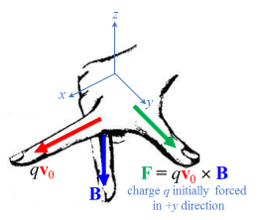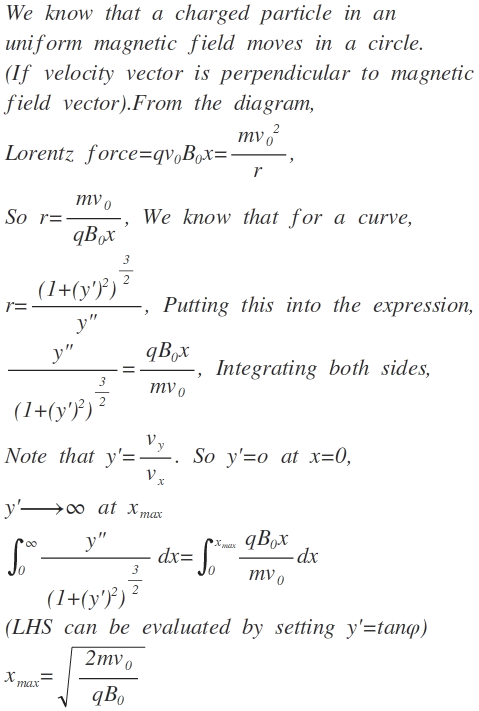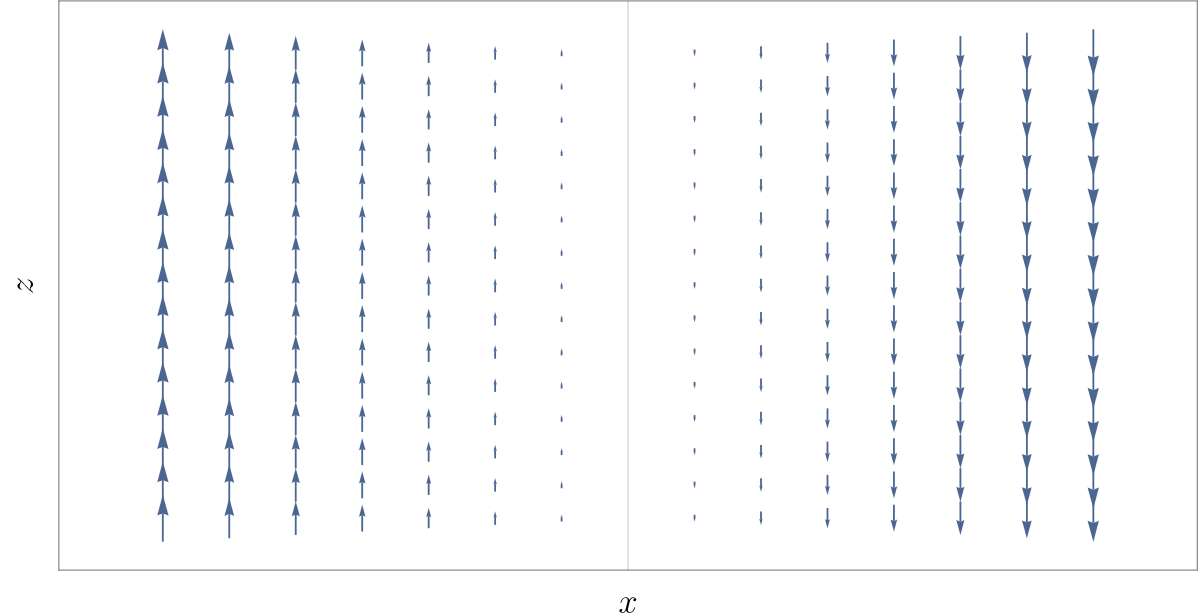Charged Particle In A Spatially Varying Magnetic Field
A spatially varying magnetic field is given by B = − B 0 x z ^ . A particle of charge q and mass m leaves the origin with initial velocity v 0 in the positive x ^ direction. Find the value of x max , the farthest horizontal displacement reached by the particle.
Details and Assumptions:
- m = 1 k g
- q = 1 C
- B 0 = 1 T / m
- v 0 = 2 m / s
The answer is 2.0.
This section requires Javascript.
You are seeing this because something didn't load right. We suggest you, (a) try
refreshing the page, (b) enabling javascript if it is disabled on your browser and,
finally, (c)
loading the
non-javascript version of this page
. We're sorry about the hassle.
5 solutions
May i know how did you plot that graph in the end? Software?
Log in to reply
I used Mathematica. But you could also use some open-source Python plotting package like
matptlotlib
or
bokehplot
.
Excellent!
Nice. Extended explanation serves to clear concepts very well. Just one tiny mistake in the determinant for the cross product. You have written B_0 both inside and outside. Apart from that very good :)
@Josh Silverman- Nice description and especially the visuals. I explicitly used energy conservation in my solution, so I posted it in case someone might benefit from it. In the last figure, I believe the y axis should be positive.
Log in to reply
Like you think the particle is moving in the wrong direction?
Log in to reply
Yes, the pcle should move in +y dir for n odd. I made a quick pic but had to dump it in my solution (see below) b/c apparently pics can't be added to comments. Thank you again.
Yeah. the field i gave was LaTeX: B = − B 0 x z ^ . . The negative sign was deliberate so that it goes in positive y. But its okay, very minor error.
Let the components of velocity of particle along x-axis be v(x) and along y axis be v(y).
Now d t d x =v(x) and a(y)= d t d v ( y )
I can resolve the magntic force as: a(y)=Bxv(x)
d t d v ( y ) =Bx d t d x
d{v(y)}=Bx(dx)
Integrating both sides to get
v(y)=B 2 x 2 +c
At t=0 v(y)=o and at the instant when x=x(max) v(y)=v
Solving we get v=B 2 x ( m a x ) 2
Hence x(max)=2
Perfect. :)
Log in to reply
Thanks. Did you like my solution?
Log in to reply
Yeah. Short and sweet.
Log in to reply
@Jatin Sharma – Thanks bro. Are you on slack? @Jatin Sharma
@Jatin Sharma do see this solution.
Different approach! Very good! My original solution was somewhat like this. using radius of curvature :)
See my solution to the problem A charge in motion.
Putting the given data in the formula obtained for x m a x , we get
x m a x = q B 0 2 v 0 m = 1 ⋅ 1 2 ⋅ 2 ⋅ 1 = 4 = 2
Cool. Short and sweet.
The particle with mass m and charge q is launched from the origin r = 0 with initial velocity v 0 = v 0 x ^ into a magnetic field B = − B 0 x z ^ which exerts a force F = q v × B at all times on the particle. When the particle has a velocity v = v x x ^ + v y y ^ + v z z ^ , by Newton's second law, it will experience an acceleration v ˙ = a = F / m = ( q / m ) v × B . Defining α ≡ q B 0 / m and substituting in for v and B yields: v ˙ = m q ( v x x ^ + v y y ^ + v z z ^ ) × ( − B 0 x z ^ ) = − α d e t ⎣ ⎡ x ^ v x 0 y ^ v y 0 z ^ v z x ⎦ ⎤ = − α ( v y x x ^ − v x x y ^ ) . In terms of components, ( 1 ) d t d v x ( 2 ) d t d v y ( 3 ) d t d v z = − α x v y = α x v x = α x d t d x = α 2 1 d t d [ x 2 ( t ) ] ⇒ v y ( t ) = 2 1 α x 2 ( t ) + const and v y ( 0 ) = 0 = x ( 0 ) ⇒ v y ( t ) = 2 1 α x 2 ( t ) = 0 , when combined with v z ( 0 ) = 0 ⇒ v z ( t ) = 0 . These are easier to analyze in reverse order. (3) tells us that the particle's motion is confined to the x - y plane. (2) gives an expression for the y -component of velocity which shows in particular that v y ≥ 0 , i.e., the particle drifts only in the + y -direction . (1) shows that, because v y is always non-negative, the particle is always accelerated towards the y -axis (i.e., towards x = 0 except when x = 0 ), and that the restoring acceleration gets larger when the particle tries to get further away from the y -axis. In fact, subbing v y ( t ) into (1) gives x ¨ ( t ) = − 2 1 α 2 x 3 ( t ) , an equation similar to that for a simple harmonic oscillator except that it has a cubic restoring force versus a linear one - see Note 1. Thus, the particle is expected to reach extreme displacements away from x = 0 at some ± x m a x values before being forced to return.
The value of x m a x can be determined from energy conservation. Note that B does no work on the particle because the force it exerts is always orthogonal to the particle trajectory: d W = F ⋅ d s = F ⋅ v d t = q v × B ⋅ v d t = q v × v ⋅ B d t = 0 . Therefore, the particle's energy at any point on its trajectory is entirely kinetic, 2 1 m v 2 , and equals its initial kinetic energy 2 1 m v 0 2 ⇒ v 0 2 = v 2 . At extreme x -displacement x = x m a x , v x = 0 and v y = 2 1 α x m a x 2 . Since v z = 0 always, v 0 2 = v 2 = v x 2 + v y 2 + v z 2 = 0 + ( 2 1 α x m a x 2 ) 2 + 0 ⇒ v 0 = 2 1 α x m a x 2 ⇒ x m a x = q B 0 2 m v 0 = 1 ⋅ 1 2 ⋅ 1 ⋅ 2 = 2 m.
Note 1: The x -motion can be regarded as that of a mass m at the origin connected to a spring exerting a non-linear force of F x = − k x 3 with a spring constant k = 2 1 q 2 B 0 2 / m . Such a force is conservative and the spring would have potential energy U ( x ) = 4 1 k x 4 . If the mass at rest at the origin (where the spring is not compressed nor extended) is given an initial velocity v 0 , then x m a x can be obtained by equating the initial kinetic energy to the potential energy when the mass is momentarily at rest at max displacement: 2 1 m v 0 2 = K = U = 4 1 k x m a x 4 .
Note 2: Whenever the particle crosses the y -axis, the trajectory is orthogonal to it. This follows because v y ( t ) = 2 1 α x 2 ( t ) = 0 when x ( t ) = 0 . In this case, v 2 = v x 2 = v 0 2 = 0 , so the particle's velocity is a non-zero vector in the x direction when it crosses the y -axis.
Note 3: Considering as Josh did a magnetic field B = − B 0 x n z ^ for integral n ≥ 1 , (2) becomes instead:
( 2 ′ ) d t d v y = α x n v x = α n + 1 1 d t d [ x n ( t ) ] ⇒ v y ( t ) = n + 1 1 α x n + 1 ( t )
which, when substituted into (1), changes the x equation of motion as follows:
( 1 ′ ) d t d v x = − α x n v y ⇒ x ¨ ( t ) = − n + 1 1 α 2 x 2 n + 1 ( t ) .
Interestingly, for any positive integer n , the force term F x = − k x 2 n + 1 is always restoring since it has odd symmetry in x or, equivalently, the particle moves in an even potential U ( x ) = 2 n + 2 1 k x 2 n + 2 . For n even, B does not change direction for negative x , unlike the original problem where n = 1 is odd. However, v y ( t ) does change direction from + y to − y for negative x . These two changes combine to not only keep the x equation of motion oscillatory but also to cause the trajectory to be an orbit , unlike the drifting "S" pattern trajectory for n odd.


Before we start our calculation, let's take a look at the magnetic field. In this flat representation of the field we see that as we move away from the axis, the magnitude of the field grows.
Moreover, the field is negative at positive
x
and positive at negative values of
x
.
In this flat representation of the field we see that as we move away from the axis, the magnitude of the field grows.
Moreover, the field is negative at positive
x
and positive at negative values of
x
.
In a magnetic field of constant strength, we expect charged particles to orbit in circles. This doesn't change when the field varies in space. Therefore, as the particle moves into regions of higher field strength, we expect charged particles to to travel in curved trajectories of decreasing radius. Near the y -axis, we expect the trajectory to settle into straight lines.
When the particle crosses the y -axis, the sign of the magnetic field flips so we expect the direction of curvature to flip as well. Thus, the particle should move back and forth across the y -axis, making 1 8 0 ° turns on either side as it works its way down the y -axis.
We can generalize fields of this kind a la B = − B 0 x n z ^ . For n = 0 we have the classic vertical field of constant strength and we expect the particle to move in circles. As n grows, the magnetic field starts to ramp up in strength more quickly as we venture away from the y -axis, causing the particle to turn around closer and closer to the axis.
The crux of the calculation is the Lorentz force law v ˙ = m q v × B . Writing it out in component form, we have
v ˙ = m q v × B = − m q B 0 x n ( v x x ^ + v y y ^ ) × z ^ = − m q B 0 x n det ⎝ ⎛ x ^ v x 0 y ^ v y 0 z ^ v z 1 ⎠ ⎞ = − m q B 0 x n ( v y x ^ − v x y ^ )
If we let α = m q B 0 and expand the left hand side into component form, we have ⟨ v x ˙ , v y ˙ ⟩ = α x n ⟨ − v y , v x ⟩ or v x ˙ v y ˙ = − α v y x n = + α v x x n
Now these coupled differential equations are not straightforward to resolve—as we reasoned earlier, the trajectory is some curve who radius changes with distance from the axis. We know that when the particle turns around its velocity is purely in the y direction, so that v x = 0 . We also know that magnetic fields do no work (even when they're spatially variant), so v y = v 0 at the point of turn around.
Taking the equation for v y ˙ , we have d t d v y = d x d v y d t d x = d x d v y v x , so that d x d v y v x d x d v y = α v x x n = α x n This yields 0 ∫ v y ( T ) d v y v y ( T ) = 0 ∫ x max x n d x = n + 1 α x max n + 1 which leads to x max = ( α ( n + 1 ) v 0 ) n + 1 1
We can confirm our qualitative argument about the trajectory of the particle by numerically solving the system for ⟨ x , y ⟩ :